- Early
- Posts
- Starting With Clarity Is Crucial For Dream Job Success
Starting With Clarity Is Crucial For Dream Job Success
Use These Questions To Create Massive Clarity & Start Your Job Hunt Right
Welcome to the first edition of the UpEmployment Newsletter 👋
Together we’ll land you more dream job offers in less time and with less stress.
I hope you had an amazing first full week of February.
To kick things off, I want to say thank you and I’m excited you’re here.
We have never met, but if you’re reading this, I know you’re a fellow Career Champion.
Ok, that sounds like a compliment but wtf is a Career Champion?
What is a Career Champion?
A Career Champion isn’t satisfied with an “out of the box” career.
We’re people that want to live extraordinary lives of growth, excitement, connection, and purpose.
We don’t just want the NEXT job. We want the BEST job.
Career Champions hunt for roles that will accelerate us toward that ideal future version of ourselves.
But we don’t live for a destination in the future.
We do the uncommon thing to put ourselves in a position to drive significant impact and enjoy the journey.
I’m just like you
I haven’t always been a Career Champion.
In fact, 10 years ago, the only thing I was champion of was the beer pong table.
For years after college, I was stuck in a soul-sucking cubicle data entry job living in a tiny basement apartment and working for the weekend.
I hadn’t put much thought into my career and it showed.
I was making half of what my friends were making, I wasn’t learning anything, I wasn’t growing, and felt like I was quickly being left behind.
But, despite all that, I was ambitious and knew that if I could channel my energy into a company and mission I was excited about, the sky was the limit.
February 21, 2012
I didn’t know it then, but my entire life would change over the course of the next 12 months. And it all started with a simple journal entry.
After being rejected from my company’s Management Trainee Program for the third time, I lost all hope.
But rock bottom can be a useful moment.
I realized that no one was coming to save me, and I needed to chart a future for myself.
So, I began to read and journal.
I started with the book Think and Grow Rich by Napoleon Hill.
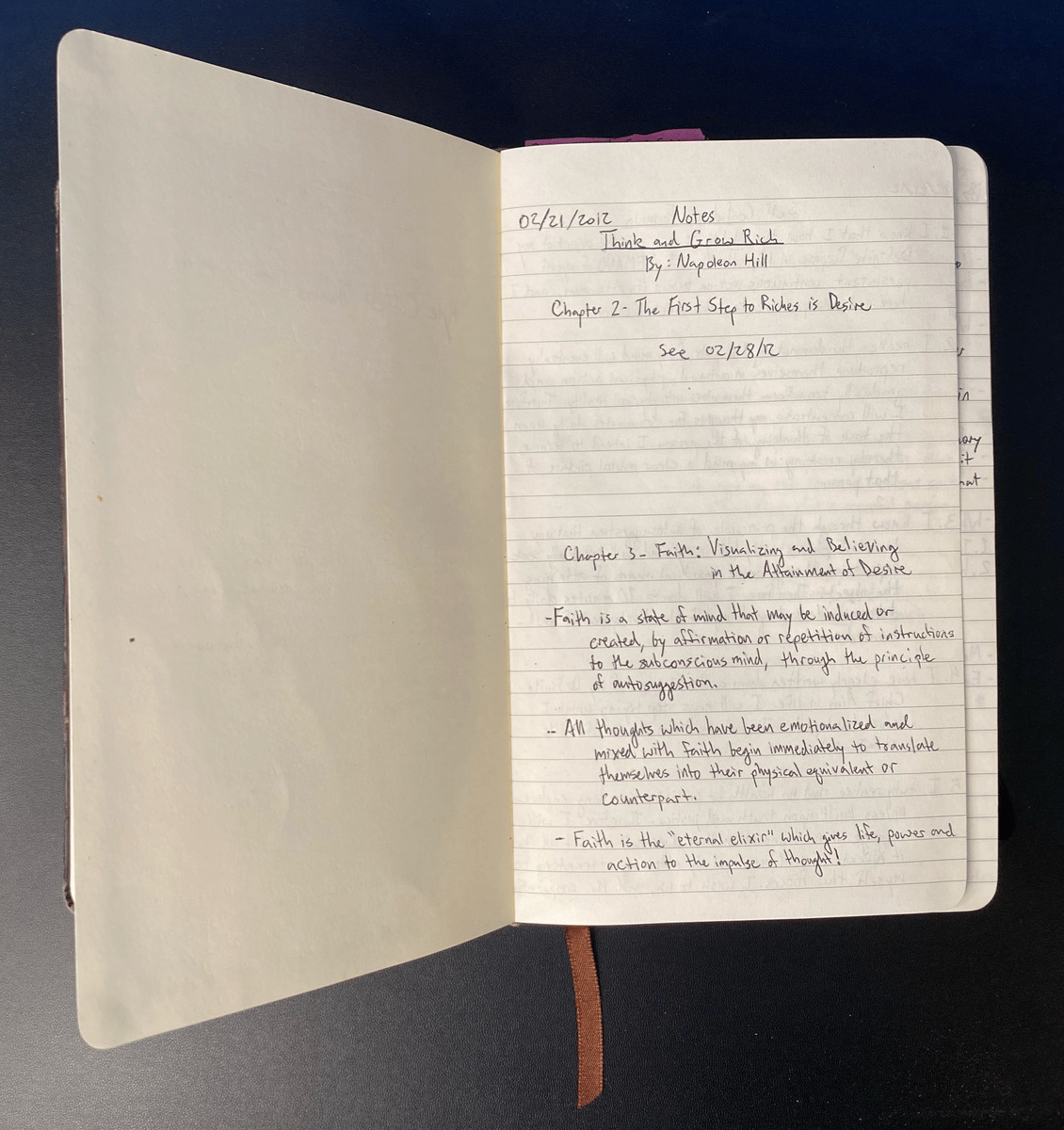
The first of many journal entries that led me to a life-changing outcome.
What happened next?
Cue the wildest year of my life.
Over the next 12 months, I would:
Backpack solo across Guatemala (I don’t speak any Spanish)
Read 13 books about personal development
Start an entrepreneurship club with some friends
Craft some crappy business ideas
Meet my future wife in the middle of a crowd of 320k people at an EDM festival in Las Vegas
Start a long-distance relationship (me in SEA, my girlfriend in NYC)
Save up three months of expenses
Quit my job in Seattle
Move to New York City
Move in with my girlfriend (now wife) and her three roommates
Almost run out of money
Land a job as the 250th employee of Uber
Double my salary and secure millions of dollars in stock options
Completely change my life
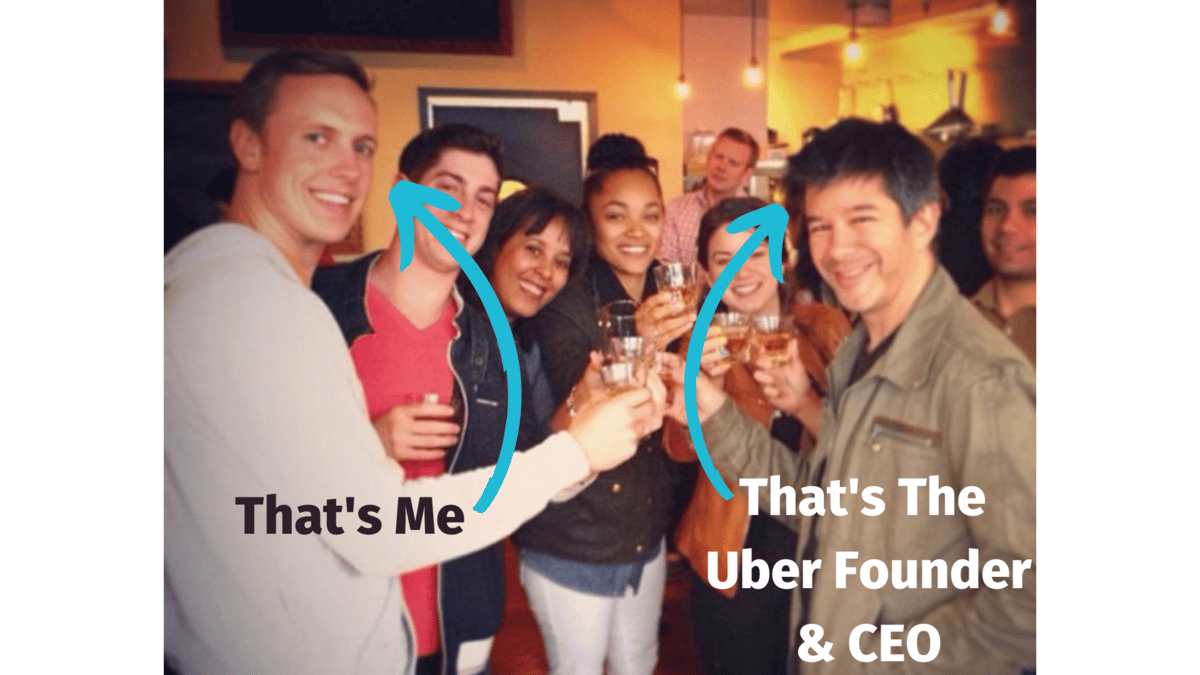
My first month at Uber.
I worked at Uber for seven years and helped to expand the company throughout the Northeast US. I launched Uber in New York State, New Jersey, and Connecticut and e-bikes in New York City. I was also in the room when we pitched the CEO and Founder of Uber on what would become UberEATS.
I woke up every day excited to get to the office and constantly said to myself, “I can’t believe I get to do this.”
It was a dream job and the experience of a lifetime.
The Next Chapter & My Realization
During the pandemic, Uber sold their micro-mobility business (e-bikes & e-scooters) to a competitor. As a result, they laid off the entire team, myself included.
After almost a decade on the dream job rocketship, my journey had come to an end.
One thing became crystal clear as I looked at the job search landscape.
NOTHING HAD CHANGED!
I had been out of the job search game for over 7 years but all of the advice, tools, methods, and resources were identical to a decade prior.
The advice hadn’t changed but the job landscape had changed dramatically.
With the move to remote and hybrid working and the ease of online applications, it had become far more competitive than ever before.
So what did I do?
I knew the “traditional” advice of updating my resume and cover letter, sending in my application, and hoping to get noticed hadn’t been what landed me my dream role at Uber.
So I recreated the process that had worked for me and put it to work.
My 90-Day Dream Job
Once again, within less than 90 days, I had landed a role as VP of Operations at a well-funded startup coming out of Y-Combinator. It increased my salary by over $100k and checked off almost every box of my Dream Job Description.
The day I landed that job, I jumped on a call from a woman I worked with at Uber to help her with her job search. She had also been laid off.
As she told me the details, she started to cry.
“I’ve applied to 300 jobs and haven’t gotten anywhere. I don’t know what to do!”
That was when I knew I had to do something.
She was a smart person, she just didn’t have the right strategy.
What I have found is it takes work to craft a dream job hunt properly, but anyone can do it.
This newsletter will give you all you need to know to land your dream job.
So read until the end and stay tuned for future editions.
I also share insights on LinkedIn so you can follow along, and we can chat there too!
The Cost of Doing It Wrong
The average job search lasts five to six months.
That’s a long time.
Let’s say that you make $100k per year, and you could get a 10% increase in salary (an additional $10k) at your next company (table stakes with my students).
Your job search will cost you at least $4k-$5k in unrealized earnings if you are employed. ($833 per month you could earn at your Dream Job)
If you are unemployed, your job search will cost you over $30k due to unrealized earnings and household expenses. ($833 in earnings plus $5,111 avg US household expenses per month)
That’s a lot of money you could put somewhere else.
Why People Get It Wrong And Why It’s Not Your Fault?
This is what the typical job search looks like.
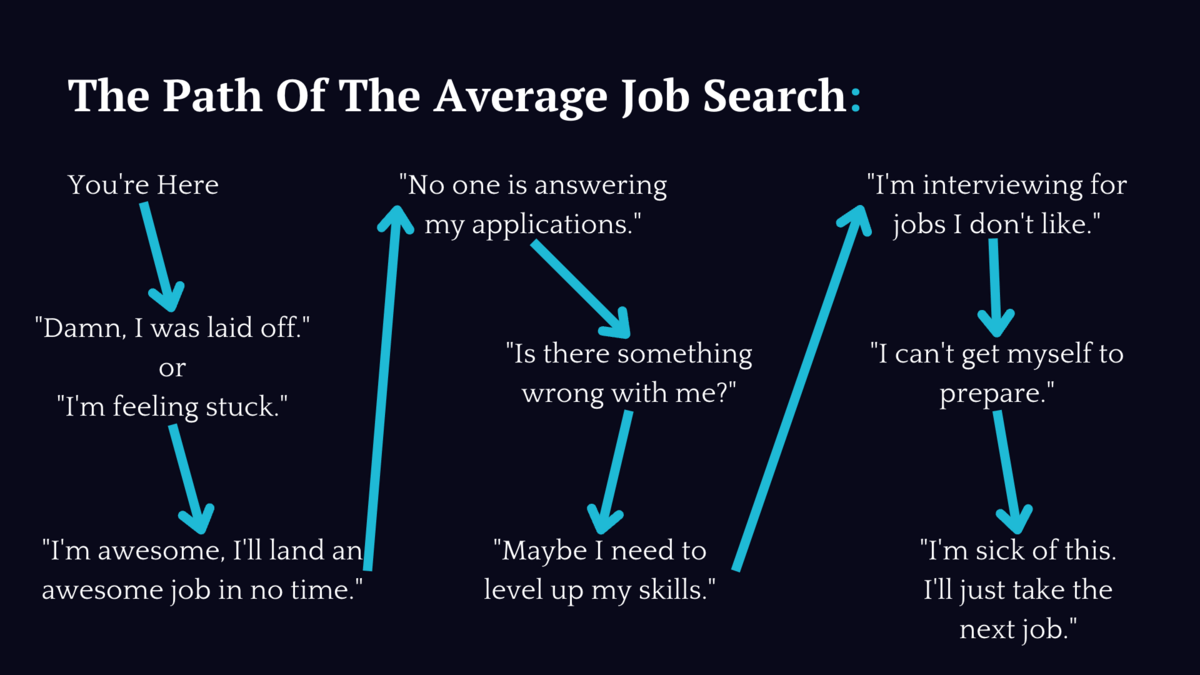
Look familiar?
The reason why 90% of us fall into this cycle is because of two things:
No one is formally taught how to look for a job.
The existing advice is to update your resume, create a cover letter, send an application, and hope to be found.
Job hunting is like personal finance.
It’s not taught in school so you have to figure it out as you go along and hope that you don’t make a big mistake along the way.
So what’s the solution?
The 5 C’s of the UpEmployment Process
When you’re purchasing a diamond, there are 5 C’s that determine the quality of the stone. Color, cut, clarity, carat weight, and certification.
There are also 5 C’s that determine the quality of your job hunt.
Your ability to perform these 5 C’s in the proper order will make or break your job hunt.
Doing them properly and in order will result in a clear, conscious, connected, and inspiring journey.
It will be a matter of when, not if, you land the role.
Doing them improperly and out of order will result in anxiety, disorientation, loneliness, and settling.
We don’t want any of those.
The 5 C’s of the Dream Job Hunt are:
Clarity
Confidence
Connection
Creation (value)
Competition
Phase 1 - Clarity
When starting any journey, you need to know where you are going.

If you were going on a hike, you wouldn’t just randomly start walking through the woods.
You would end up lost, hurt, or dead if you did.
If you heard about someone doing that, you would say to yourself, “Well, that’s pretty stupid. Of course it turned out badly. I would never do that.”
But people do that in their job hunt all the time.
They don’t think about where they want to go and just start taking action in random directions.
In future newsletters, we’ll dive deeper into what happens if you don’t start here, but for now, take my word for it and start by creating massive clarity.
Ok, so we know what not to do (take immediate action without thinking), but what should we be doing?
Glad you asked.
Start by asking yourself the following questions
Where have I been?
Where am I now?
Where do I want to be in 2-5 years?
Where Have You Been?
The best way to get your bearings on where you are now is to understand where you have been. So, perform an analysis of all your prior roles.
What did you like about them?
What didn’t you like about them?
What environment set you up to perform at your best?
What took away from your ability to do good work?
What is your highlight reel? (Your biggest accomplishments in each role)
By going through this exercise, you’ll identify trends you want to lean into or avoid in your next role.
Also, reviewing your highlight reel is a great way to remember how big of a badass you are whenever you need a little motivation.
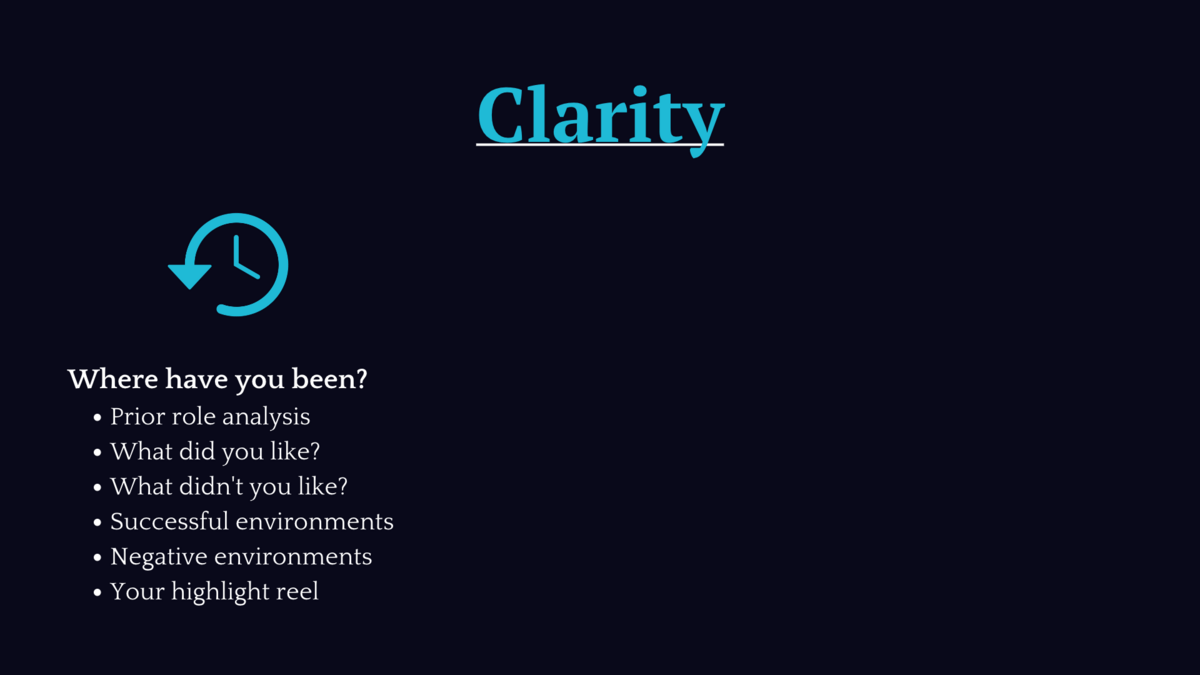
Where Are You Now?
Ok, so you know where you have been in your prior roles.
Now it’s time to take a no-BS look at where you are now.
You can do this in a few ways.
Make a list of the toolkit of skills that you have acquired up until this point and your level of strength in each of them.
You can craft this list by saying, “I have experience with…”
Go through all the hard and soft skills you have, as well as the experiences you have been through.
Example:
- I have experience creating playbooks for new market launches.
- I have experience in companies growing from 250 to 30k employees.
- I have experience onboarding new team members.
- I have experience onboarding new marketplace customers.
- I have experience in marketplace businesses.
Reach out to former coworkers, bosses, mentors, family, and friends and ask for the no-BS truth about what you’re exceptional at and what you need to work on.
Send them a text message or email using the following template:
“Hey [FIRST NAME], I’m going through an exercise to understand my strengths and weaknesses and would love some feedback.
When we were working together what would you say were the top things that I was great/good at and what things would you say were my biggest weaknesses?
I’m trying to grow and identify blind spots so don’t worry about hurting my feelings. I’m trying to create a no-BS self assessment.”
Combining your self-assessment and peer feedback should give you an accurate assessment of where you currently stand.
Your goal here is to understand everything you have to offer a future company, the problems you could solve for them tomorrow, and your true strengths and weaknesses.
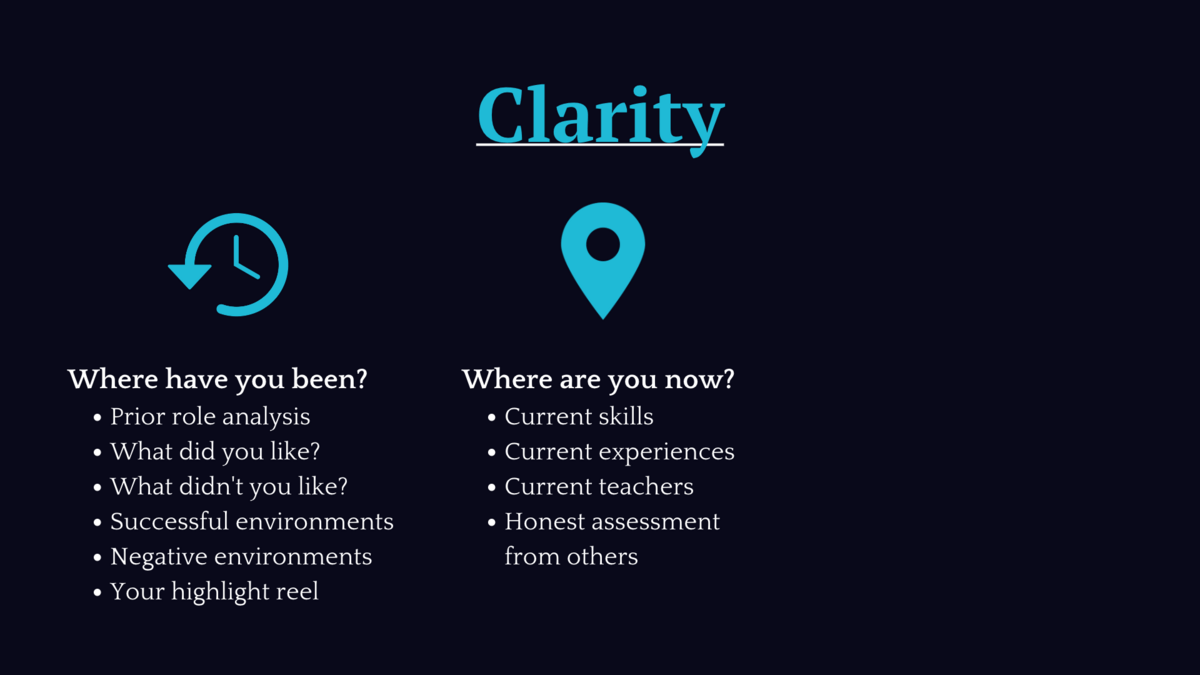
Where Are You Going?
Ok, so we have where you have been and are now.
Now comes the fun part.
It’s time to shake hands with the future version of you.

Woah, future you is jacked!
This future version of you is kicking ass and taking names.
They wake up every day excited to get to work.
They say to themselves and others, “I can’t believe I get to do this.”
This person is you in 2 to 5 years.
Why 2 to 5 years?
You likely know or can easily connect with people that are in the roles you want to have in 2 to 5 years
You can remember who you were 2 to 5 years ago. If I think of myself 10 years ago, that guy is so different than I am today he’s almost unrecognizable.
It’s enough time to chart an ambitious, realistic path but not too much time to give you excuses or create unrealistic expectations.
So ask yourself the following:
What are this person’s skills?
What experiences have they had exposure to?
Who were/are their teachers?
What does their network look like?
Where are they living?
What do they look like?
What is their title?
What industry do they work in?
What are they paid?
Who are they working with?
What does a day in their life look like?
Are they working in-person/remote/hybrid?
What’s their diet like?
What are their relationships like with friends and family?
What are they able to do for fun?
What have they built or created?
It’s key to make this picture as vivid as possible so you can get to know the future version of you and what this next role will propel you towards.
But just painting the picture isn’t the end. Now you have to ask yourself, “why?”
Why is each of those aspects of Future You important for you to achieve?
The reason that we ask “why” is to prevent you from falling into what I like to call the “Common Path Trap”.
The “Common Path Trap” is something we all get sucked into. You see others you know taking roles, joining companies, or doing similar things. See enough people doing that and it becomes your default answer. You need to separate what you want from what you think you “should” want.
Paint a vivid picture of Future You with a compelling “why, “ and it will motivate you during the challenging times of your hunt.
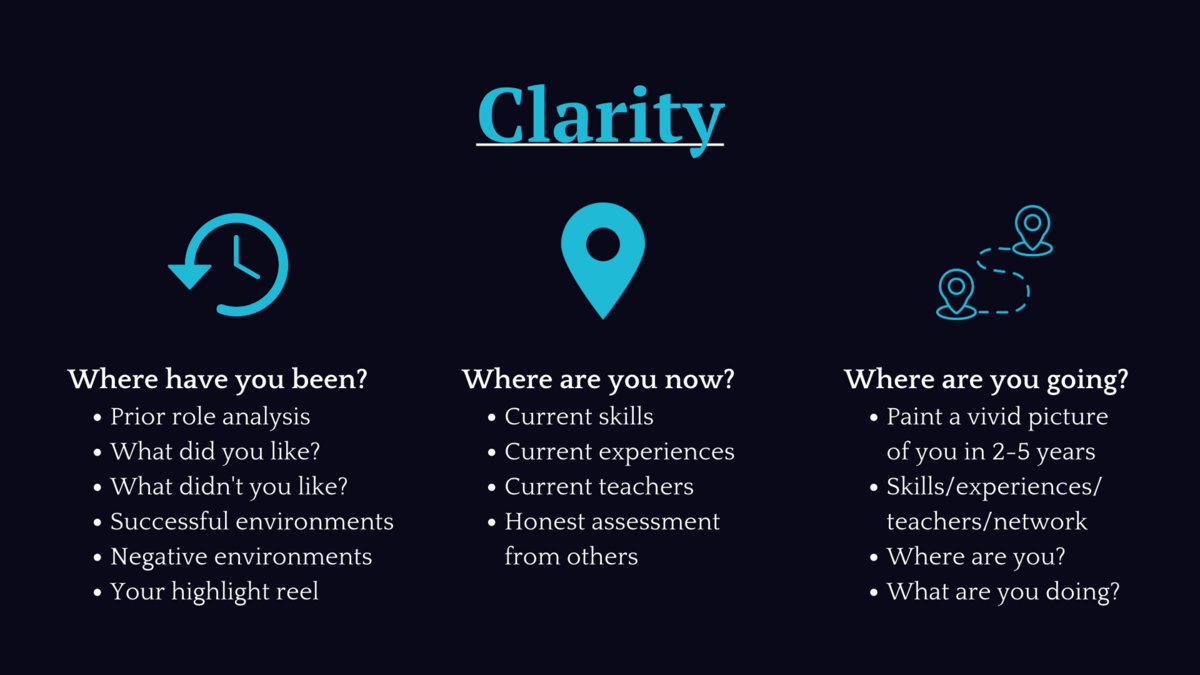
***REMINDER***
I just wanted to quickly check back in and remind you of one thing.
90% of people looking for their next role don’t go through the exercise above.
It may sound crazy but almost every person I speak with about their job hunt starts by firing off applications without even thinking about whether or not those roles will move them closer to or further away from that ideal version of themselves.
Just by doing the three simple exercises above you’ll be doing more than the VAST majority of job seekers.
But you don’t want to be a job seeker, you want to be a job hunter.
You want to identify that ideal next role and systematically hunt it down, not blindly search for whoever will take you next.
This is the first step of becoming a job hunter.
If 90% of people don’t complete this first exercise, imagine how much more competitive of a candidate you’ll be when you complete all of the 5 C’s!
What Comes Next?
The next step is crafting your dream job description.
Your Dream Job Description (DJD) describes the specific job(s) that will accelerate you toward the future version of yourself.
It will help you in three ways:
Improve Speed: Diluted focus leads to diluted results. The DJD will focus your efforts and allow them to build on top of each other. With each focused action, you’ll move faster and faster toward your dream job.
Conserve Energy: It will serve as a checklist for you to judge opportunities that come your way. Learning what to say “No” to is very powerful to prevent wasted energy.
Help Your Network Help You: It will help your network direct you to opportunities. The more specific you are, the more they can help.
For how to craft your Dream Job Description, you’ll have to come back next week!
We could go even deeper into clarity because of how important it is to set up your job hunt for success, but we’ll stop there for today.
In the coming weeks, we’ll dive deeper into each of the 5 C’s and the systems, tools, templates, and case studies that will lead to more dream job offers in less time with less stress.
I’m excited to share everything I have learned over the last 12 years and go on this journey with you!
Let’s become career champions together 🏆
Kyle
P.S. Whenever you’re ready, there are 3 ways I can help you:
#1: FREE Creating Crystal Clarity Masterclass: I’m hosting a free masterclass to dive deep into creating dream job clarity and starting your 90-Day Dream Job Hunt the right way. Save your spot today!
#2: Want to get more dream job offers in less time with less stress? Discover how to build a proven system to land your dream job in a matter of days here.
#3: Follow me on LinkedIn and Twitter for more job hunt systems, productivity tools, and networking templates.
💎 Job Op of the Week 💎
Each week I’ll highlight a different job opportunity I think is awesome and give tips for how I would approach getting into the role.

This week we have the Operations Manager position @ Harness Wealth.
What the company does: Provides tax and financial advice on your equity and business decisions.
Why is the role awesome: Matt Powers is the hiring manager. (Remember: One of the most important factors of a dream job is the teacher).
Why is Matt awesome: He was one of the earliest Uber employees, my manager at Uber for 5 years, and an amazing operational mentor for anyone looking to advance their career in tech operations.
How would I approach getting in: I would watch and listen (1,2) to all the interviews from the founders and Execs at the company. Reach out to Lee-on, Alex, and Philip with a personalized LinkedIn connection request message and email. From those conversations, I would look for areas of pain that I could alleviate immediately. Ex: I would create a sample tax advisor onboarding program and share it with them.
Apply for the job here and DM me on LinkedIn with your resume and I’ll forward it to Matt myself.
Share UpEmployment
The job hunt isn’t something you need to do alone.
In fact, if you surround yourself with other career champions, you’ll land your dream job quicker.
So share this newsletter with anyone you know that is currently looking for that next career-accelerating opportunity so you can win together!
Forward them this email or just copy and paste this link: https://upemployment.beehiiv.com/subscribe
Reply